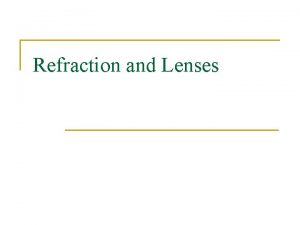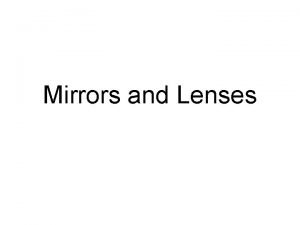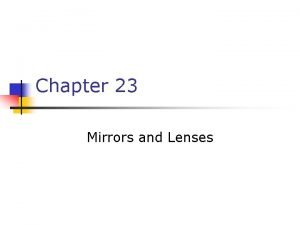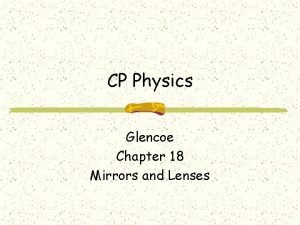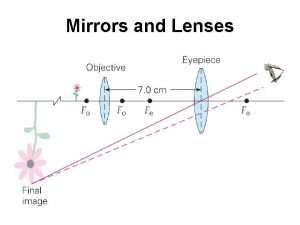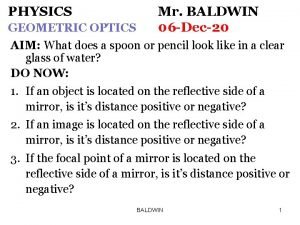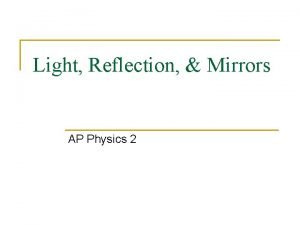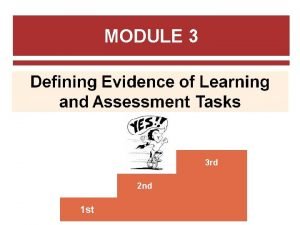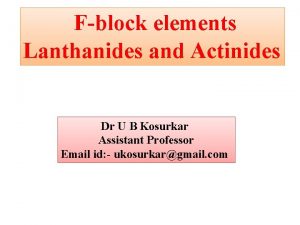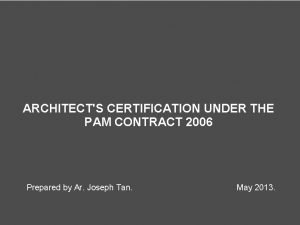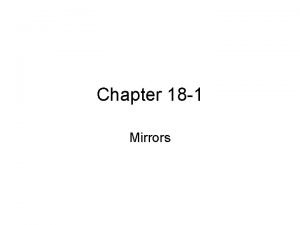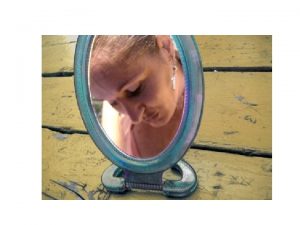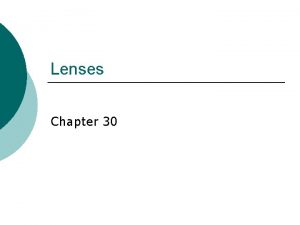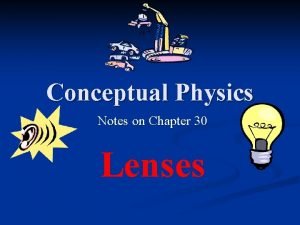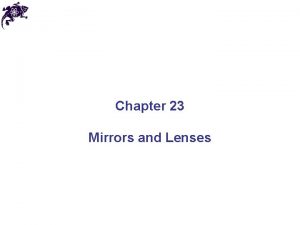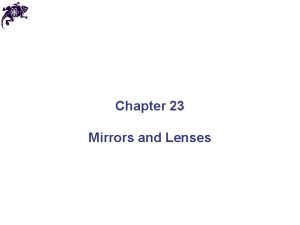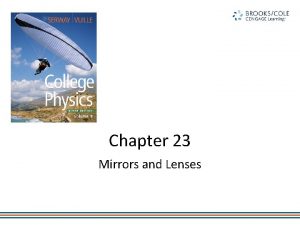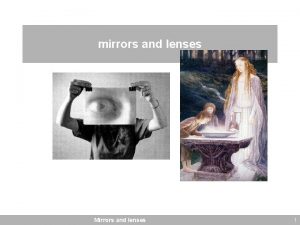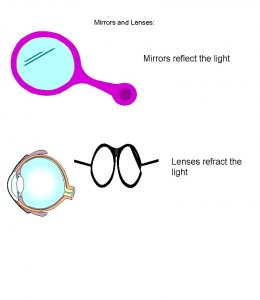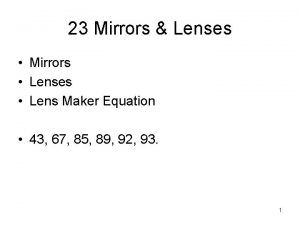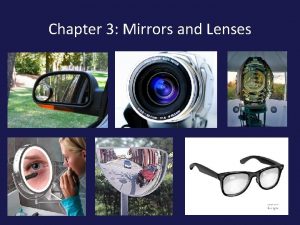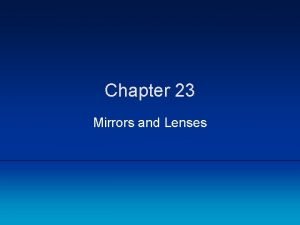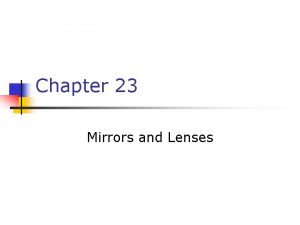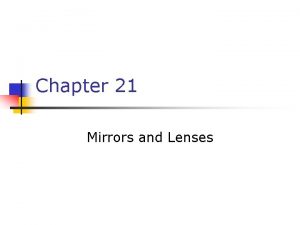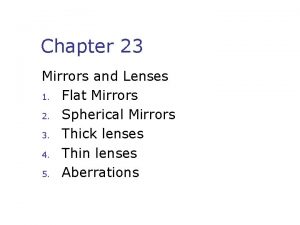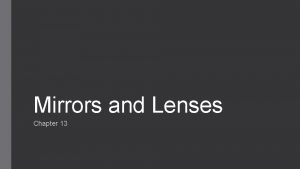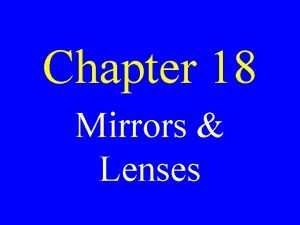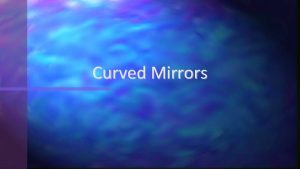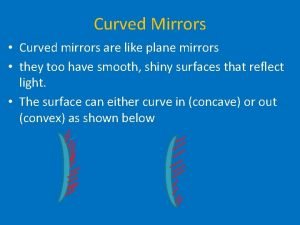Mirrors and Lenses Chapter 13 The penultimate chapter



















- Slides: 19

Mirrors and Lenses Chapter 13 The penultimate chapter!!!!

Mirrors • Recall that your eyes gather light reflected off of objects This allows you to see the objects • Light can reflect more than once Light bouncing off of you can then bounce off of a mirror This creates the image that you see in the surface of the mirror When the light rays bounce, they can change direction • Mirrors use smooth, reflective surfaces that allow light to reflect Recall that this is called regular reflection • The light from a mirror enters your eyes, from which the brain receives signals and interprets them as the image. • Different Mirrors use different shapes to cause images

“L-O-S-T” Art of Image Description • L-Location Where the object is located • O-Orientation Is the object upright or inverted • S-Size Did the object get larger or smaller • T-Type Real or Virtual

Plane Mirrors • Flat, smooth mirrors • L-The image appears as far away as the object is from the mirror If the object is 2 m from the mirror, the image will appear 4 m away • O-The image is upright • S-The object is the same size • T-Virtual image

Concave Mirrors • Mirror that curves inward (like a cave entrance) • Concave mirrors have an optical axis Perpendicular line through the center of the mirror • The curvature of the mirror causes all rays to be reflected through a focal point Point on the optical axis through which light rays converge after reflecting from the mirror • The distance from the mirror to the focal point on the optical axis is called the focal length


Ray Tracing-Concave Mirrors • Easiest way: Start from top of object Draw straight line to mirror From where line strikes mirror, draw straight line through focus 2 nd line: Start from top of object Draw straight line through focus to mirror Where ray hits mirror, draw straight line • Where the 2 rays converge (meet up) draw the image It will be upside down and slightly smaller

Concave mirror: Object outside of the focal length • L-At least a little bit outside of the focal length • O-Inverted • S-Smaller • T-Real

What about objects on the Focal Point? • No image is formed • L-On the focal point • O-none • S-none • T-none

Object between concave and focal point. • Causes mirror to magnify image of the object • L-Inside focal length • O-Upright • S-Larger • T-Virtual

Convex Mirrors • A mirror that curves outward. • Light rays diverge after striking the convex mirror They never meet • Used often for security • L-Past the focal point • O-Upright • S-Smaller • T-Virtual


Convex Mirror Ray Diagram • Focal point is on the other side “Behind the mirror” Your book has this incorrect… • A bit different than concave mirrors • First, draw a line parallel to the optical axis from the top of the object This line will then travel through the focus • Second, draw a line from the top of the object to the mirror that would travel through the focus Once it hits the mirror, it travels parallel to the optical axis • Draw the image where the lines converge

Lenses • Come in concave and convex, just like mirrors • Used in cameras, eyeglasses, contacts, etc.

Convex lenses • Lens that is thicker in the middle than the edges • Light rays are refracted so that they converge on a single point Focal length depends on the shape of the lens • They type of image depends on where the object is relative to the focal length

Concave Lenses • Lens that is thinner in the middle • Rays hit the lens and then diverge • L-Anywhere in front of the lens • O-Upright • S-Smaller • T-Virtual • Used in some eyeglasses and microscopes

Eyesight and Lenses • Light enters the eye through the cornea Transparent covering of the eye Causes light to converge through the pupil and into a convex lens called the crystalline lens Focuses rays on the retina The retina converts the light to electrical signals that travel to the brain and are interpreted • Muscles in your eye can adjust the shape of the lens and allow you to see near and far.

Vision Problems • Astigmatism Irregular curvature of cornea Corneas are more oval than round Causes blurry vision at all distances Can be corrected with lenses • Farsightedness Trouble seeing near objects clearly (eyes are focused to a distance) Light does not converge enough Corrected with convex lenses As people age, farsightedness becomes more common Lens becomes less flexible • Nearsightedness Difficulty seeing at a distance Can be corrected with concave lenses

Uses of Mirrors and Lenses • Telescopes use mirrors and lenses to gather a lot of light, and see distances Refracting telescopes use 2 convex lenses to gather and focus light Reflecting telescopes use mirrors to reflect gathered light. Some also contain lenses Usually reflecting telescopes are larger Space telescopes, such as Hubble and soon James Webb, use huge mirrors to reflect and gather light • Microscopes Use convex lenses (objective lenses and eyepiece) to magnify tiny images such as cells • Cameras Use lenses to gather light for photographs
 Refraction in lenses
Refraction in lenses Mirrors and lenses
Mirrors and lenses Mirrors and lenses
Mirrors and lenses Physics classroom lenses and mirrors
Physics classroom lenses and mirrors Mirror equation
Mirror equation Sign convention table for mirrors and lenses
Sign convention table for mirrors and lenses Ap physics 2 mirrors and lenses
Ap physics 2 mirrors and lenses Anti penultimate shell
Anti penultimate shell 5f block elements
5f block elements Penultimate certificate
Penultimate certificate Chapter 17 reflection and mirrors
Chapter 17 reflection and mirrors Is flat
Is flat Physics
Physics Chapter 30 lenses
Chapter 30 lenses Chapter 30 lenses
Chapter 30 lenses Hình ảnh bộ gõ cơ thể búng tay
Hình ảnh bộ gõ cơ thể búng tay Slidetodoc
Slidetodoc Bổ thể
Bổ thể Tỉ lệ cơ thể trẻ em
Tỉ lệ cơ thể trẻ em Gấu đi như thế nào
Gấu đi như thế nào
